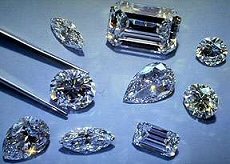| About
Diamonds
Diamond is carbon in its most concentrated form. Except
for trace impurities like boron and nitrogen, diamond is composed
solely of carbon, the chemical element that is fundamental
to all life.
But diamond is distinctly different from its close cousins
the common mineral graphite and lonsdaleite, both of which
are also composed of carbon. Why is diamond the hardest surface
known while graphite is exceedingly soft? Why is diamond transparent
while graphite is opaque and metallic black? What is it that
makes diamond so unique?
The key to these questions lie in diamond's particular arrangement
of carbon atoms or its crystal structure--the feature that
defines any mineral's fundamental properties.
|
A crystal is a solid body formed
from the bonding of atomic elements or compounds in a repeating
arrangement. Often, crystals possess smooth external faces.
Due to their symmetrical and finite nature, the building blocks
of crystals are limited to relatively small numbers of atoms,
and their chemical compositions to simple numerical combinations
of elements.

|
The 4
C's
A diamond’s beauty, rarity, and price depend on
the interplay of all the 4Cs - cut, clarity, carat, and color.
Please click on the links below for more information.
|


